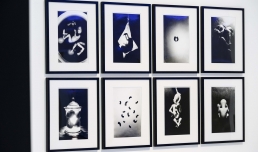Daido Moriyama with Shomei TomatsuTOKYO REVISITED
galleria 3
curated by Hou Hanru, Elena Motisi
Monday closed
Tuesday to Sunday 11 am – 7 pm
Monday 8 December 11 am > 7 pm
Wednesday 24 December 11 am > 4:30 pm
Thursday 25 December closed
Wednesday 31 December 11 am > 4:30 pm
Thursday 1 January 11 am > 7 pm
Monday 5 January 11 am > 7 pm
Tusday 6 January 11 am > 7 pm
– for young people aged between 18 and 25 (not yet turned 25);
– for groups of 15 people or more;
– La Galleria Nazionale, Museo Ebraico di Roma ticket holders;
– upon presentation of ID card or badge: Accademia Costume & Moda, Accademia Fotografica, Biblioteche di Roma, Centro Sperimentale di Cinematografia, Enel (for badge holder and accompanying person), FAI Fondo Ambiente Italiano, Feltrinelli, Gruppo FS, IN/ARCH Istituto Nazionale di Architettura, Sapienza Università di Roma, LAZIOcrea, Palazzo delle Esposizioni, Amici di Palazzo Strozzi, Accademia Nazionale di Santa Cecilia, Scuola Internazionale di Comics, Teatro Olimpico, Teatro dell’Opera di Roma, Teatro di Roma, Università degli Studi di Roma Tor Vergata, Youthcard;
valid for one year from the date of purchase
– minors under 18 years of age;
– myMAXXI cardholders;
– on your birthday presenting an identity document;
– upon presentation of EU Disability Card holders and or accompanying letter from hosting association/institution for: people with disabilities and accompanying person, people on the autistic spectrum and accompanying person, deaf people, people with cognitive disabilities and complex communication needs and their caregivers, people with serious illnesses and their caregivers, guests of first aid and anti-violence centres and accompanying operators, residents of therapeutic communities and accompanying operators;
– MiC employees;
– journalists who can prove their business activity;
– European Union tour guides and tour guides, licensed (ref. Circular n.20/2016 DG-Museums);
– 1 teacher for every 10 students;
– AMACI members;
– CIMAM International Committee for Museums and Collections of Modern Art members;
– ICOM members;
– from Tuesday to Friday (excluding holidays) European Union students and university researchers in art history and architecture, public fine arts academies (AFAM registered) students and Temple University Rome Campus students;
– IED Istituto Europeo di Design professors, NABA Nuova Accademia di Belle Arti professors, RUFA Rome University of Fine Arts professors;
– upon presentation of ID card or badge: Collezione Peggy Guggenheim a Venezia, Castello di Rivoli Museo d’Arte Contemporanea, Sotheby’s Preferred, MEP – Maison Européenne de la Photographie;
limited seating; it is mandatory to arrive at the infopoint 15 minutes before the start time indicated on the ticket; the experience lasts approximately 45 minutes
limited seating; it is mandatory to arrive at the infopoint 15 minutes before the start time indicated on the ticket; the experience lasts approximately 45 minutes
MAXXI’s Collection of Art and Architecture represents the founding element of the museum and defines its identity. Since October 2015, it has been on display with different arrangements of works.

galleria 3
curated by Hou Hanru, Elena Motisi
Monday closed
Tuesday to Sunday 11 am – 7 pm
Monday 8 December 11 am > 7 pm
Wednesday 24 December 11 am > 4:30 pm
Thursday 25 December closed
Wednesday 31 December 11 am > 4:30 pm
Thursday 1 January 11 am > 7 pm
Monday 5 January 11 am > 7 pm
Tusday 6 January 11 am > 7 pm













Describing themselves as ‘stray dogs running through the city while unconsciously looking around’, the two artists take pictures of everyone who moves in front of them.
Tokyo is one of the most fascinating cosmopolitan cities in the world, offering an infinite wealth of sources of inspiration for artistic creation. Photography, especially street photography, represents its most original expression thanks to famous names such as Daido Moriyama and his master Shomei Tomatsu. They have always been committed to exploring the situations of post-war Japanese society and its contemporary evolution.
Tomatsu actively works by capturing socially and politically engaging scenes. On the other hand, Moriyama likes to immerse himself in the joy and excitement produced by the consumer society. However, both artists share the same way of treating photography more as a way of life than as an artistic genre.
Visitors are invited to physically “revisit” Tokyo, connecting it with Roman reality: a city poised between eternal negotiation with its historic ruins, and futuristic projections for tomorrow.
header: Daido Moriyama, How to Create a Beautiful Picture: Tights in Shimotakaido, 1987 Courtesy: Akio Nagasawa Gallery
videogallery
Radicals: Seijun Suzuki, Kaneto Shindō, Kazuo Ōno
On the occasion of the exhibition, a special screening of films by directors and creatives who share with Daido Moriyama a countercurrent, revolutionary and never conventional look at Japan. The pop and surreal character of Seijun Suzuki (19 luglio > 7 agosto), the more rigorous and austere nature of Kaneto Shindō (9 > 28 agosto) and the mystical essence of Kazuo Ōno’ Butō dance (30 agosto > 18 settembre) represent different manifestations of a common need to narrate the duality of post-war Japan, to bring to light the shadows and fragility of existence, to break taboos, and to reaffirm the individual’s freedom of choice and expression.
contenuti correlati